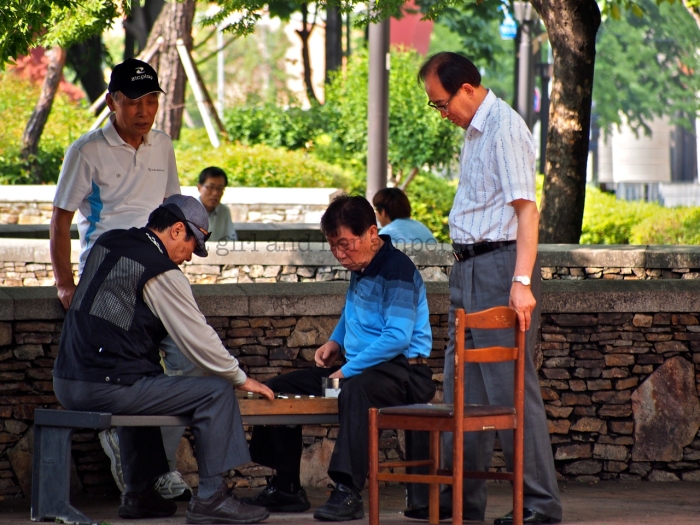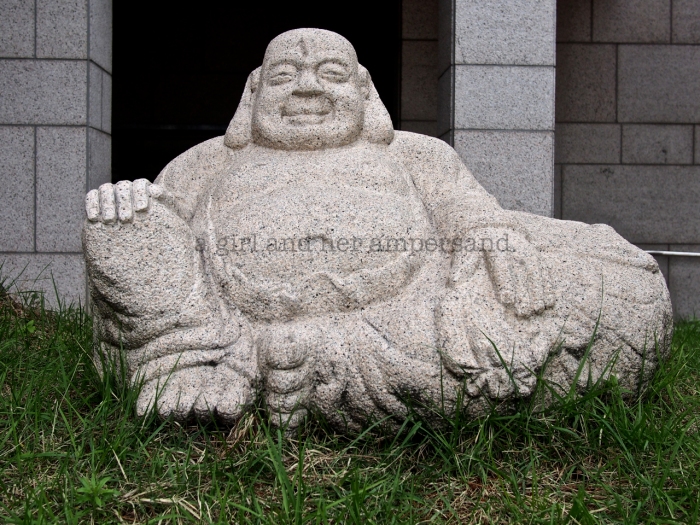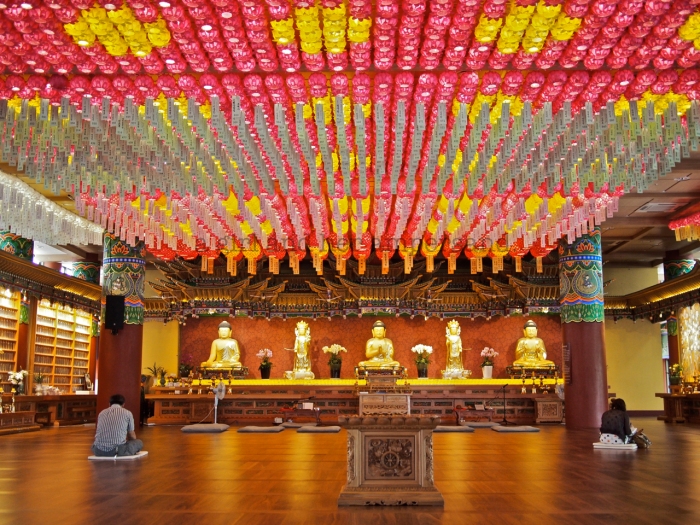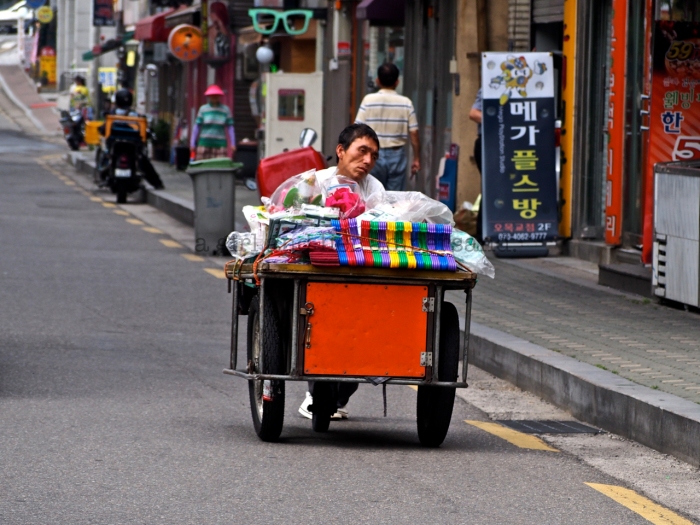 Omokgyo is nice. I can’t think of another part of Seoul we’ve visited that’s more aptly described by that adjective, with its satisfied, bourgeois, slightly anodyne tones. With its upper middle to upper class housing, ample parkland, abundance of shopping, and well kempt streets, it struck me as what a friendly urban planner might come up with if given carte blanche.
Omokgyo is nice. I can’t think of another part of Seoul we’ve visited that’s more aptly described by that adjective, with its satisfied, bourgeois, slightly anodyne tones. With its upper middle to upper class housing, ample parkland, abundance of shopping, and well kempt streets, it struck me as what a friendly urban planner might come up with if given carte blanche.
I began by heading towards, Omok Bridge (오목교), from Exit 5. At the start of the bridge a ramp led down to the Anyang Stream (안양천), flanked on both sides by wide swaths of green, somewhat uncharacteristically untended and simply let to grow semi-wild. There were a few trees among the tall grasses, weeds, clover, and wildflowers. Things grew well; flowers and weeds were sprouting up in the cracks between bricks in the sidewalk, something I almost never see in Seoul. Further south two large sections of golden flowers on the slope up to the highway were in full bloom.
I neared the slow moving stream, and with the tall grasses now out of the way I could clearly see a pair of black storks standing unmoving in the middle of the water. A fish broke the surface, jumping out once, twice maybe thirty feet from them, but the birds didn’t move, knowing that it was too far away, knowing better than to get excited about it. As they continued to wait a duck flew by, so low above the water that I thought its wings would dip on the downstrokes. Then the faint synth lines began to grow louder, a biker rode by with Psy’s ‘Gentleman’ blaring from his handlebar-mounted stereo, and the spell was broken.
There were quite a few bikers pedaling up and down the tracks along the stream, most of them on serious bikes and in serious biking suits, holding true to the Korean attitude that if a hobby is worth doing it’s worth being done far more professionally than necessary. Some of the enthusiasts had stopped for a break on one of the benches in the rest area under the bridge, where some seniors were also playing croquet on one of the two courts there. Just upstream of the bridge a white egret stabbed its vermicelli neck into the water and then, coming up unsuccessful, rose into the air and floated upstream to try another spot. I wondered if I was just being incredibly lucky with bird sightings or if this was the norm for the Anyang when I noticed the first of several signs asking people to be quiet, as the area was a migratory bird preservation area. Ahem, ‘Gentleman’ guy.
If you follow the stream as it makes its lazy way toward the Han River, you’ll come to another couple sights of note, though both are more quickly reached by going out Exit 4, going east on Omok-ro (오목로), turning left when you reach the bridge, and following the sidewalk along the highway ramp. Up ahead on your right, sitting above the traffic, will be Yeonghakjeon Pavilion (영학정). Originally on the other side of the Anyang Stream and moved in 1977, it long ago served as a vantage point from which to observe a military training base and the military’s archery practice. Today it can still be used for similar purposes, as below the pavilion, down a set of stairs, is a Korean and Western Style Archery Range (궁도장–양궁장). At one end was a canopied row of seats with overhead hooks on which archers could hang their bows; at the other end of a long swath of mowed grass, maybe 100 yards away, stood three targets, and every so often one of the dozen people beneath the canopy would let their fingers slip from the string and second or two later a dull thwack would carry up to the pavilion.
Not far from the stream, the neighborhood’s most immediately noticeable feature is the Hyperion apartment towers, which soar over the area’s many other apartment complexes, even above the nearby 180-meter-plus Trapalace apartments. At 256 meters and 69 floors, Tower A was for a short time the tallest building in South Korea. (It’s now the second tallest in Seoul and the sixth tallest overall.) It remains one of the toniest addresses in the city, and there was no shortage of imported German automobiles parked near the entrance to the underground parking lot when I visited.
The apartments are located just across the street from Exit 2, but if you happen to live in them you needn’t bother going outside should you deign to leave your Mercedes at home and take the subway. The three towers are connected at their base by a Hyundai Department Store and U-Plex shopping mall that make up the first floor and basement levels, and these are in turn linked to the station by a block-long tunnel, along which a lengthy moving walkway glides under TVs that blared ads for the musical ‘Jack the Ripper’.
Just before the entrance into the malls is the actual exit, and I popped onto a quiet street across from the Hyperion where a fruit stand and a few pojangmachas sat on the sidewalk. Across the street was an elementary school, its fence swaddled in roses, as many fences in the neighborhood were. On the sidewalk outside two ajeosshis waited for the rush of students when school ended; one of them sold cotton candy from the back of a motorcycle, the other had a small stand advertising ‘diet hoddeok,’ whatever that might be.
Behind the school is Omok Park (오목공원), where well-tended bushes shared space with exercise equipment, badminton courts; a red, yellow, blue, and silver hourglass-shaped sculpture; and a large central plaza, with a fountain in one corner and the Yangcheon-gu logo embedded in the floor. A middle school gym class was listening to their teacher on the basketball courts, adults were either watching over the kids who were running around everywhere or were simply relaxing, and around some benches above the central plaza a group of 20 or 30 wheelchair users were gathered in a group outing.
East of the park and across the street from the rear of the Hyperion/Hyundai Department Store complex was a plaza area lined with restaurants, cafes, and shops, and which led to another shopping mall. This elongated plaza, Learning Street (배움의 거리), continued north, between apartment towers, office buildings, a post office, and past Sun and Moon Fountain Plaza (썬앤문분수광장). Here a small manmade channel curled between sun and moon arches at either end, though the fountains hadn’t been turned on yet.
At its north end, the promenade deposited me just in front of Paris Park (파리공원), slightly larger than Omok, with signs seeming to indicate the park’s commemoration of South Korean-French relations. An undulating walking path wound around its edge, past a barefoot walking path, flower beds, and gazebos where studying college students took the place of the usual crowd of gabbing ajeosshis or ajummas. On the east side, set amid flower bushes, were 1/100 and 1/125 models, respectively, of the Eiffel Tower and Arc d’Triomphe. At the park’s north end was a huge pool. Signs around it ordered visitors not to go into the fountain, though this fountain, like the ones in Omok Park and Sun and Moon Fountain Plaza, wasn’t turned on either. Without the splashing water, the only aesthetic the pool possessed, with its Slushee blue color, was as a pool, and the only thing that seemed worth doing, temptingly so, was exactly what the sign prohibited: going in for a dip. (Ed. – By the time Merissa got to the park, however, the fountains had been turned on.)
Southeast of Paris Park is the Mokdong Stadium Complex (목동종합운동장), built in the late ‘80s and which you can walk to from Exit 3 or 4. As a big baseball fan I’ve been to Jamsil Stadium a number of times to watch my adopted team, the Doosan Bears, play, but I’d never visited Mokdong, home to the KBO’s Nexen Heroes, so I was curious to see how it stacked up. Unfortunately, the grounds here have zero character, with the baseball stadium flanked by a soccer stadium and an ice rink, and all three surrounded by nothing but parking lots. Apart from a health club and a screen golf place, there didn’t seem to be anything that was open to the general public. By the time I’d circled nearly around the complex a broadcast truck and a couple groups of fans had shown up, waiting outside the closed ticket windows for the night’s game, which was still several hours away. Some kimbap and fried potato stick sellers had set up on the sidewalk outside the complex as well, and while they helped improve the atmosphere a bit it all still struck me as rather desolate.
That was in contrast to the rest of the neighborhood, which, despite being largely residential, is neither desolate nor dull. The streets above the long tunnel to Exit 2, in between Exit 1 and the Hyperion, are filled with restaurants, bars, and noraebangs, and though it all adds up to a very small amount of nightlife, it’s all that’s needed here.
The area to the south of the station and Omok-ro is perhaps better known to expats as most everyone has had to make the trip from Exit 7 down Cheonhoji-gil (천호지길) to the Immigration Office at one time or another. And if they have they’ve likely noticed the large, red and black wood building in a style that could be called Modern Pagoda just to its right on Mokdongdong-ro (목동동로). This is the Jogye Order of Korean Buddhism International Zen Center (대한불교조계종 국제선센터), which was opened in 2010 and, among other things, runs Templestays and houses a temple food restaurant, 발우공양 공감. There was a stone statue of a fat, happy Buddha outside and colorful lotus lanterns on a second floor patio, and as I stood gazing up at them a student rolled up to the school across the street on a unicycle, which, with its minimalism and demand for balance, struck me as a very Buddhist form of transportation.
Except for this small area around Immigration and the Zen Center, the south side of Omokgyo had been a mystery for me, so after wending my way back to the station from the Zen Center I went back, this time taking the first right out of Exit 5, Sinmok-ro-2-gil (신목로2길), and following it south. Immediately there was a huge construction area where yet another pair of new apartment towers was slated to go in, but beyond this the neighborhood showed some signs of an earlier, more modest Omokgyo. Amid the apartment towers was a middle-class collection of red brick apartments, real estate offices, and small places to eat and shop. The street also soon brought me to Sinjeong Market (신정시장), which, besides being pleasingly alliterative in the original Korean, added a down-to-earth touch to the neighborhood. The market ran down a single lane. Awnings of the stalls on either side met in the middle, making the market nearly covered, and the smell of fish in summer air filled the space underneath. It was quiet on a Tuesday afternoon, what little business there was consisted of visored ajummas pulling carts or toting plastic bags. A fish flopped about in an aerated tank and a man rolled through on an electric bike.
Just past the market, the new apartment high rises with roses wrapped around their fences began again, and as I wound through the back streets, making an elongated U back towards the station, these places and the after school academies and the late model cars on the street reinforced my earlier assumptions that most of the people living in Omokgyo have probably ticked off all the boxes. It was a nice neighborhood for nice people living nice lives. Back near the station, in an enormous flower bed on a traffic island at the intersection of Omok-ro and Mokdongdong-ro, in the shadow of the Trapalace towers, a dozen groundskeepers trimmed bushes and pulled weeds.
Anyang Stream (안양천)
Exit 5
East on Omok-ro (오목로)
Yeonghakjeon Pavilion (영학정) and Korean and Western Style Archery Range (궁도장–양궁장)
Exit 4
East on Omok-ro (오목로), Left at bridge
Omok Park (오목공원)
Exit 2
Straight on Mokdongseo-ro (목동서로)
Learning Street (배움의 거리) and Sun and Moon Fountain Plaza (썬앤문분수광장)
Exit 2
Straight on Mokdongseo-ro (목동서로), Right on first street
Paris Park (파리공원)
Exit 2
Straight on Mokdongseo-ro (목동서로)
Mokdong Stadium Complex (목동종합운동장)
Exit 3
Straight on Sinmok-ro (신목로), Left on Mokdongdong-ro (목동동로), First right also onto Mokdongdong-ro (목동동로)
Jogye Order of Korean Buddhism International Zen Center (대한불교조계종 국제선센터)
Exit 7
Straight on Sinmok-ro (신목로), Right on Sinmok-ro-7-gil (신목로7길), Right on Mokdongdong-ro (목동동로)
02) 2650-2242
Sinjeong Market (신정시장)
Exit 5
Right on Sinmok-ro-2-gil (신목로길2길)









































Pingback: Weekly SEOUL: Korea Through Her Birds | SEOUL Magazine